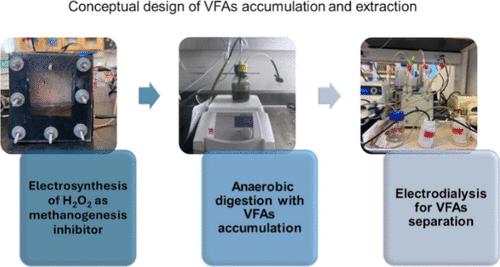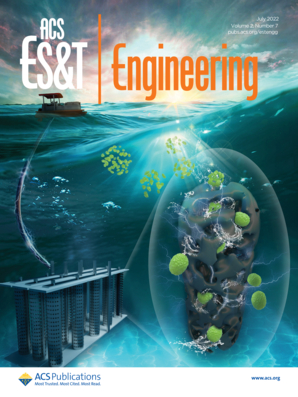Volatile Fatty Acid Production through Arresting Methanogenesis by Electro-Synthesized Hydrogen Peroxide in Anaerobic Digestion and Subsequent Recovery by Electrodialysis
IF 7.4
Q1 ENGINEERING, ENVIRONMENTAL
引用次数: 0
Abstract
Producing volatile fatty acids (VFAs) in anaerobic digestion (AD) is of strong interest because of VFAs’ potential values in biomanufacturing. Despite some success of VFA production via pretreatment, in situ inhibition of methanogens for VFA accumulation has yet to be explored. Herein, a system consisting of hydrogen peroxide (H2O2) production, application of H2O2 for inhibiting methanogens in AD, and VFA separation was investigated. A polytetrafluoroethylene-based electrospinning electrode was synthesized and capable of generating ∼4.2 g L–1 H2O2. When the generated H2O2 was applied to the AD, methanogens were inhibited, and VFA accumulation occurred. With the addition of 80 mg L–1 H2O2, an average VFA concentration of 10.6 g COD L–1 was obtained. The long-term H2O2 inhibition effect on methanogenesis was examined for nearly 100 days. A 2.3- to 3.3-fold increase in malondialdehyde levels, which indicated increased cell damage, along with a significant decrease in methane production and an increase in VFA concentration, might suggest that H2O2 could potentially inhibit methanogens while allowing acidogenic bacteria to remain functional. The accumulated VFAs were separated and then recovered using an electrodialysis unit, with a maximum VFA concentration of 26.7 g COD L–1. The results of this study will encourage further exploration of the proposed system for VFA production by addressing several challenges, including a better understanding of the inhibition mechanism and a further increase in VFA yields.

在厌氧消化过程中通过电合成过氧化氢阻止甲烷生成并随后通过电渗析进行回收来生产挥发性脂肪酸
由于挥发性脂肪酸在生物制造中的潜在价值,在厌氧消化(AD)过程中产生挥发性脂肪酸(VFAs)引起了人们的浓厚兴趣。尽管通过预处理生产挥发性脂肪酸取得了一些成功,但原位抑制甲烷菌积累挥发性脂肪酸的研究仍有待探索。本文研究了一个由过氧化氢(H2O2)生产、应用 H2O2 抑制厌氧消化(AD)中的甲烷菌以及 VFA 分离组成的系统。研究人员合成了一种聚四氟乙烯基电纺电极,该电极能够产生 ∼4.2 g L-1 H2O2。将生成的 H2O2 加到厌氧消化池中,甲烷菌受到抑制,VFA 开始积累。添加 80 mg L-1 H2O2 后,VFA 平均浓度为 10.6 g COD L-1。对 H2O2 对甲烷生成的长期抑制作用进行了近 100 天的研究。丙二醛含量增加了 2.3 至 3.3 倍,表明细胞损伤加剧,同时甲烷产量显著减少,VFA 浓度增加,这可能表明 H2O2 有可能抑制甲烷菌,同时允许产酸菌继续发挥作用。利用电渗析装置分离并回收累积的 VFA,VFA 的最大浓度为 26.7 g COD L-1。这项研究的结果将鼓励进一步探索拟议的 VFA 生产系统,解决几个难题,包括更好地了解抑制机制和进一步提高 VFA 产量。
本文章由计算机程序翻译,如有差异,请以英文原文为准。
求助全文
约1分钟内获得全文
求助全文
来源期刊

ACS ES&T engineering
ENGINEERING, ENVIRONMENTAL-
CiteScore
8.50
自引率
0.00%
发文量
0
期刊介绍:
ACS ES&T Engineering publishes impactful research and review articles across all realms of environmental technology and engineering, employing a rigorous peer-review process. As a specialized journal, it aims to provide an international platform for research and innovation, inviting contributions on materials technologies, processes, data analytics, and engineering systems that can effectively manage, protect, and remediate air, water, and soil quality, as well as treat wastes and recover resources.
The journal encourages research that supports informed decision-making within complex engineered systems and is grounded in mechanistic science and analytics, describing intricate environmental engineering systems. It considers papers presenting novel advancements, spanning from laboratory discovery to field-based application. However, case or demonstration studies lacking significant scientific advancements and technological innovations are not within its scope.
Contributions containing experimental and/or theoretical methods, rooted in engineering principles and integrated with knowledge from other disciplines, are welcomed.
 求助内容:
求助内容: 应助结果提醒方式:
应助结果提醒方式:


